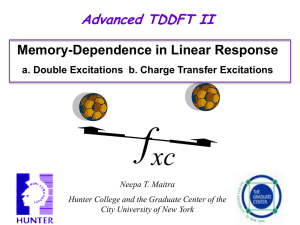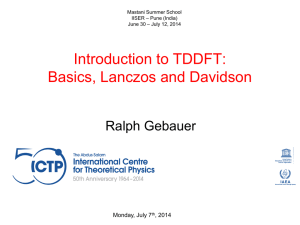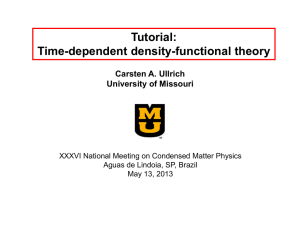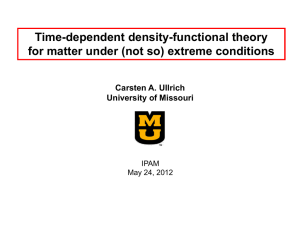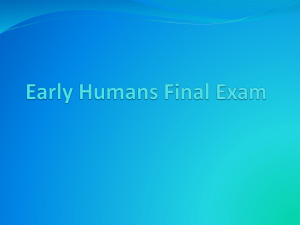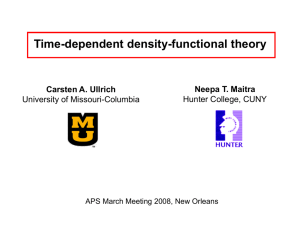Advanced TDDFT III
advertisement
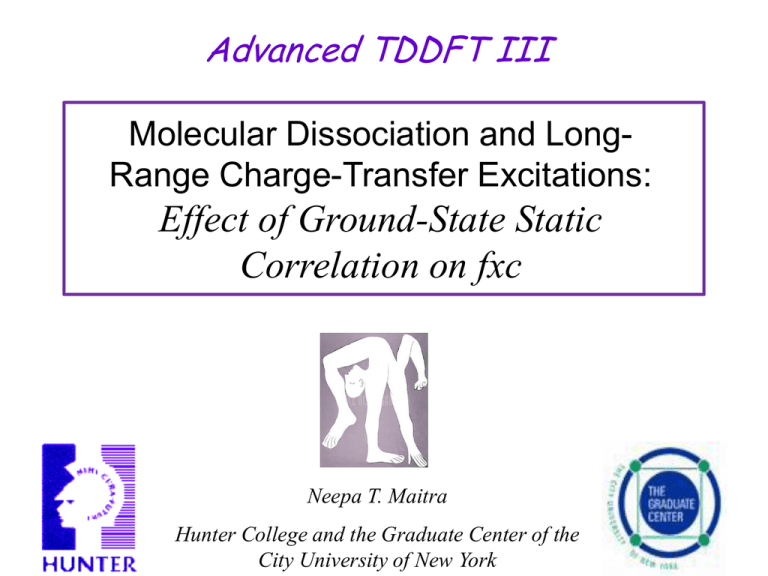
Advanced TDDFT III Molecular Dissociation and LongRange Charge-Transfer Excitations: Effect of Ground-State Static Correlation on fxc Neepa T. Maitra Hunter College and the Graduate Center of the City University of New York Plan -- Exact KS potential in molecular dissociation -- Long-range charge-transfer excitations -- Simplest model of CT to exactly solve to get an idea about fxc(w) Exact ground-state KS potentials… For 2-e systems, easy to find if know the exact density, since f(r) = (r ) 2 and so Eg. the Helium atom: H r/a0 Already the KS excitations are pretty good, and most fxc approxs give similar corrections Petersilka, Burke, & Gross IJQC 80, 534 (2000) TDDFT linear response from exact helium KS ground state: How about a Simple Model of a Diatomic Molecule? Model a hetero-atomic diatomic molecule composed of open-shell fragments (eg. LiH) with two “one-electron atoms” in 1-d: “softening parameters” (choose to reproduce eg. IP’s of different real atoms…) Can simply solve exactly numerically Y(r1,r2) extract (r) exact Exact ground-state KS potentials… Molecular Dissociation (1d “LiH”) n Vs Vext x “Peak” and “Step” structures. Vext (step goes back down at large R) VHxc peak R=10 asymptotic step x J.P. Perdew, in Density Functional Methods in Physics, ed. R.M. Dreizler and J. da Providencia (Plenum, NY, 1985), p. 265. C-O Almbladh and U. von Barth, PRB. 31, 3231, (1985) O. V. Gritsenko & E.J. Baerends, PRA 54, 1957 (1996) O.V.Gritsenko & E.J. Baerends, Theor.Chem. Acc. 96 44 (1997). D. G. Tempel, T. J. Martinez, N.T. Maitra, J. Chem. Th. Comp. 5, 770 (2009) & citations within. N. Helbig, I. Tokatly, A. Rubio, JCP 131, 224105 (2009). The Step step, size DI bond midpoint peak • Step has size DI and aligns the atomic HOMOs DI vs(r) • Prevents dissociation to unphysical fractional charges. LDA/GGA – wrong, because no step! n(r) Vext DI “Li” “H” • At which separation is the step onset? peak Step marks location and sharpness of avoided crossing between ground and lowest CT state.. Tempel, Martinez, Maitra, J. Chem. Theory Comp. 5, 770 (2009). vHxc at R=10 step asymptotic A Useful Exercise! To deduce the step in the potential in the bonding region between two open-shell fragments at large separation: Take a model molecule consisting of two different “one-electron atoms” (1 and 2) at large separation. The KS ground-state is the doubly-occupied bonding orbital: where f0(r) n(r) / 2 and n(r) = f12(r) + f22(r) is the sum of the atomic densities. The KS eigenvalue e0 must = e1 = -I1 where I1 is the smaller ionization potential of the two atoms. Consider now the KS equation for r near atom 1, where and again for r near atom 2, where Noting that the KS equation must reduce to the respective atomic KS equations in these regions, show that vs, must have a step of size e1 - e2 = I2 –I1 between the atoms. The Peak • A “kinetic correlation” effect (Gritsenko, van Leeuwen, Baerends JCP 1996). Also occurs in stretched H2 • Another interpretation: peak pushes away density from the bonding region: Asymptotically, with peak in vs no peak in vs but with the LCAO Error – most significant in bonding region peak in vc acts as a barrier to push back to the atomic regions this extraneous density. Tempel, Martinez, Maitra, JCTC 5, 770 (2009) Helbig, Tokatly, & Rubio, JCP 131, 224105 (2009). Capturing the Step and Peak in Approximations: Hard! Need non-local n-dependence • Self-interaction-corrected LDA appears to have step- and peak-like features Vieira, Capelle, Ullrich, PCCP 11, 4647 (2009) – quantum well studies) • Baerends functional B01: functional of occupied and selected virtual orbitals (Baerends PRL 87 133004 (2001)) Inspired by density-matrix functional theory. Does the B01 potential have the step and peak? Step ~ difference in electron affinities, DA < DI What about the peak? It’s actually a dip!! So far: • Discussed step and peak structures in the groundstate potential of a dissociating molecule • Fundamentally, these stark structures arise due to the single-Slater-determinant description of KS (one doubly-occupied orbital) – the true wavefunction, requires minimally 2 determinants (Heitler-London form) • In practise, could treat ground-state by spin-symmetry breaking good ground-state energies but wrong spindensities Next: What are the consequences of the peak and step beyond the ground state? Response and Excitations Implications for Static Response • Step: Similar step structure seen with homo-atomics in electric fields Eg: Stretched-H2 in E-field, e = 0.001 au H ------10au------H exact vHxc(1) exact vs(1) E-field LDA vxc(1) Fieldcounteracting step Stepsize eR exactly compensates the field in exact KS potential. two locally polarized H atoms • But usual functional approximations completely miss this step, and therefore yield fractional charges (global charge transfer) • Related problem: usual functionals overestimate polarizabilities of long-chains. -- Need non-local spatial dependence Peaks: appear in zero-field potential (not shown), act as barriers to transport – neglected in present-day transport calculations What about TDDFT excitations of the dissociating molecule? Recall the KS excitations are the starting point; these then get corrected via fxc to the true ones. Step KS molecular HOMO and LUMO delocalized and near-degenerate “Li” LUMO HOMO But the true excitations are not! “H” De~ e-cR Near-degenerate in KS energy Static correlation induced by the step! Find: The step induces dramatic structure in the exact TDDFT kernel ! Implications for long-range charge-transfer. Plan -- Exact KS potential in molecular dissociation -- Long-range charge-transfer excitations -- Simplest model of CT to exactly solve to get an idea about fxc(w) TDDFT typically severely underestimates Long-Range CT energies Eg. Zincbacteriochlorin-Bacteriochlorin complex (light-harvesting in plants and purple bacteria) TDDFT predicts CT states energetically well below local fluorescing states. Predicts CT quenching of the fluorescence. ! Not observed ! TDDFT error ~ 1.4eV Dreuw & Head-Gordon, JACS 126 4007, (2004). But also note: excited state properties (eg vibrational freqs) might be quite ok even if absolute energies are off (eg DMABN, Rappoport and Furche, JACS 2005) Why usual TDDFT approx’s fail for long-range CT: First, we know what the exact energy for charge transfer at long range should be: Ionization energy of donor e Electron affinity of acceptor Now to analyse TDDFT, use single-pole approximation (SPA): -As,2 -I1 • i.e. get just the bare KS orbital energy difference: missing xc contribution to acceptor’s electron affinity, Axc,2, and -1/R • Also, usual ground-state approximations underestimate I Dreuw, J. Weisman, and M. Head-Gordon, JCP 119, 2943 (2003) Tozer, JCP 119, 12697 (2003) Wait!! !! We just saw that for dissociating LiH-type molecules, the HOMO and LUMO are delocalized over both Li and H fxc contribution will not be zero! Important difference between (closed-shell) molecules composed of HOMO delocalized over both fragments (i) open-shell fragments, and (ii) those composed of closed-shell fragments. HOMO localized on one or other Revisit the previous analysis of CT problem for open-shell fragments: Eg. apply SMA (or SPA) to HOMOLUMO transition But this is now zero ! q= bonding antibonding Now no longer zero – substantial overlap on both atoms. But still wrong. How to get accurate CT from TDDFT? Many attempts in the recent literature. Earlier ones motivated by the fact that CIS (and TDHF) get the correct 1/R asymptote, but, having no correlation, absolute energies are off by ~1eV. So what about a hybrid? Pure TDDFT: donor-acceptor overlap 0 Hybrids with HF: (1- cHF) - cHF fi (r )fi ' (r ) But, this asymptotically gives -cHF/R, not -1/R 1 fa (r ' )fa ' (r ' )drdr' | r - r '| Non-zero correction to bare KS energies So, look to other schemes… Attempts to fix TDDFT for CT… E.g. Dreuw, Weisman, & Head-Gordon, JCP (2003) – use CIS curve but shifted vertically to match DSCF-DFT to account for correlation E.g. Tawada, Tsuneda, S. Yanagisawa, T. Yanai, & K. Hirao, J. Chem. Phys. (2004): “Range-separated hybrid” with empirical parameter m Short-ranged, use GGA Long-ranged, use Hartree-Fock, gives -1/R E.g. Stein, Kronik, and Baer, JACS 131, 2818 (2009); Baer, Livshitz, Salzner, Annu. Rev. Phys. Chem. 61, 85 (2010) – range-separated hybrid, with nonempirical “optimally tuned” m: Choose m to give the closest fit of donor’s HOMO to it’s ionization energy, and acceptor anion’s HOMO to it’s ionization energy. Leeor Kronik talk next week! Note: idea of range-separated hybrids in ground-state came from Leininger, Stoll, Werner, Savin, Chem. Phys. Lett. (1997) Note also: hybrids do fall under rigorous “generalized Kohn-Sham theory”, see Görling and Levy, JCP (1997) …attempts to fix TDDFT for CT: E.g. Heßelmann, Ipatov, Görling, PRA 80, 012507 (2009) – exact-exchange (EXX) kernel (non-empirical) E.g. Gritsenko & Baerends JCP 121, 655, (2004) – model kernel to get CT excitations correct in the asymptotic limit, switches on when donor-acceptor overlap becomes smaller than a chosen parameter fxc ~ exp(const* R) | r1 - r2 | E.g. Hellgren & Gross, arXiv: 1108.3100v1 (2011) – shows discontinuity in fxc as a function of # electrons; demonstrates relation to a diverging spatial step in fx (using EXX) that grows exponentially with separation Maria Hellgren talk next week!! E.g. Fuks, Rubio, & Maitra, PRA 83, 042501 (2011) – explores use of symmetrybreaking for the case of open-shell fragments, to avoid the static correlation problem. E.g. Vydrov, Heyd, Krukau, & Scuseria (2006), 3 parameter range-separated, SR/LR decomposition… E.g. Zhao & Truhlar (2006) M06-HF – empirical functional with 35 parameters!!! Ensures -1/R. ? Can we find a simple model to explicitly solve for the EXACT xc kernel and understand the origin of eg. the exp(cR) behavior better? Try two-electron system – two “1-e atoms “ at large separation. This is two open-shells – recall: “Li” “H” Step KS molecular HOMO LUMO De~ e-cR and LUMO delocalized and Near-degenerate near-degenerate HOMO in KS energy But the true Static correlation induced by the step that fxc excitations are not! must undo ! Undoing KS static correlation… “Li” “H” f0 LUMO f0 HOMO De~ e-cR These three KS states are nearly degenerate: The electron-electron interaction splits the degeneracy: Diagonalize true H in this basis to get: Heitler-London gs CT states where atomic orbital on atom2 or 1 What does the exact fxc looks like? Diagonalization is (thankfully) NOT TDDFT! Rather, mixing of excitations is done via the fxc kernel...recall double excitations lecture… KS density-density response function: only single excitations contribute to this sum Finite overlap between occ. (bonding) and unocc. (antibonding) Vanishes with separation as e-R Interacting response function: Vanishing overlap between interacting wavefn on donor and acceptor Finite CT frequencies Extract the xc kernel from: Exact matrix elt for CT between open-shells Within the dressed SMA the exact fxc is:… _ … … f0f0 - nonzero overlap KS antibonding transition freq, goes like e-cR d (w1 - w2)/2 Interacting CT transition from 2 to 1, (eg in the approx found earlier) Note: strong non-adiabaticity! Upshot: (i) fxc blows up exponentially with R, fxc ~ exp(cR) (ii) fxc strongly frequency-dependent Maitra JCP 122, 234104 (2005) (i)Also for closedshell CT, and for homoatomics (Gritsenko and Baerends (JCP 2004)) How about higher excitations of the stretched molecule? • Since antibonding KS state is near-degenerate with ground, any single excitation f0 fa is near-generate with double excitation (f0 fa, f0 fa) • Ubiquitous doubles – ubiquitous poles in fxc(w) • Complicated form for kernel for accurate excited molecular dissociation curves • Even for local excitations, need strong frequency-dependence. N. T. Maitra and D. G. Tempel, J. Chem. Phys. 125 184111 (2006). But almost no approximate vs has the step, so is static correlation and w-dep. relevant practically ?? Yes ! Orbital energy • Static correlation is an important feature of LDA and GGA’s too: LiH in LDA LUMO HOMO R HOMO and LUMO become degenerate as the molecule dissociates Orbital energy LiH in LDA LUMO HOMO R HOMO and LUMO become degenerate as the molecule dissociates • As the molecule dissociates into fractional charged species (Li+0.25 H-0.25 ), the atomic potentials distort so as to align the highest levels of Li and H. The LiH molecular HOMO and LUMO are both delocalized over both atoms. So, again, any single excitation fH fa is near-degenerate with the double (fH,fH) (fa,fL) requiring again strongly frequency-dependent fxc for both local and CT excitations. Summary Long-range charge-transfer excitations are particularly challenging for TDDFT approximations to model, due to vanishing overlap between the occupied and unoccupied states. Require exponential dependence of the kernel on fragment separation for frequencies near the CT ones. Strong frequency-dependence in the exact xc kernel is needed to accurately capture long-range charge-transfer excitations in a molecule composed of open-shell species Origin of complicated w-structure of kernel is the step in the groundstate potential – making the bare KS description a poor one. Static correlation. Static correlation problems also in conical intersections. Note also : general problem with non-overlapping occupied-unoccupied transitions, even when no CT, discussed in Hieringer & Görling Chem. Phys. Lett. 419, 517 (2006)
